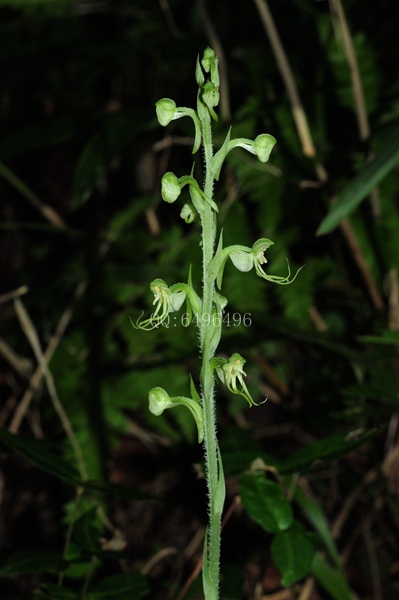
- Scientific Name: Habenaria ciliolaris Kraenzl.
- Ref: Bot. Jahrb. Syst. 16:169. 1892
- Synonym: Habenaria kweitschuensis Schltr.
- Chinese Common Name: 毛葶玉凤花 máotíng yùfèng∙huā, 丝裂玉凤花 sīliè yùfèng∙huā, 玉凤兰 yùfèng∙lán
- Japanese Common Name: ネバリサギソウ [粘り鷺草] nebarisagisō
- Family: Orchidaceae
- Genus: Habenaria
- Distribution: Shaded places in forests or along valleys; 100-1800 m. N Fujian, SE Gansu, Guangdong, Guangxi, Guizhou, Hainan, Hubei, Hunan, Jiangxi, Sichuan, Taiwan, S Yunnan, Zhejiang [Vietnam].
- Photo: Mt. Tianmu, Zhejiang
- Type: Asia orientalis: Hongkong. Little Hongkong (from Herb. Hongkong. Botan. Garden. Comm. C. Ford, 14. Aug. 1884).
Plants 25-60 cm tall. Tubers narrowly ellipsoid or oblong, 3-5 × 1.5-2.5 cm, fleshy. Stem erect, terete, stout, with 5 or 6 leaves near middle and 5-10 bractlike leaves above. Leaf blade elliptic-lanceolate, obovate-spatulate, or narrowly elliptic, 5-16 × 2-5 cm, base contracted and amplexicaul, apex acuminate or acute. Raceme 6-30-flowered, 9-23 cm; peduncle and rachis ridged, ridges villous; floral bracts ovate, 13-15 mm, shorter than ovary, ciliate, apex acuminate; ovary twisted, cylindric-fusiform, denticulate-ridged, including pedicel 23-25 mm. Flowers white or greenish white, rarely tinged with pink. Dorsal sepal forming a concave hood with petals, saccate, broadly ovate, 6-9 × 5.5-8 mm, abaxially 3-keeled, 5-veined, toward apical margin ciliate; lateral sepals reflexed, strongly oblique, ovate, 6.5-10 × 4-7 mm, 3- or 4-veined, apex acute. Petals obliquely lanceolate, 6-7 × 2-3 mm, unlobed, 1-veined, apex acuminate; lip longer than sepals, deeply 3-lobed from base; lobes parallel, filiform; lateral lobes 20-22 mm; mid-lobe pendulous, 16-18 mm; spur pendulous, curved, cylindric-clavate, 21-27 mm, slightly longer or shorter than ovary, dilated toward end, apex obtuse; stigmas oblong, ca. 1.5 mm. Fl. Jul-Sep. (Flora of China)
